American crooner Bing Crosby signs an autograph for a boy in the Olympics Stadium in Rome on Sept. 7, 1960. Crosby was in the stadium to see the 50 kilometer road walkers arrive. At left is his wife Kathryn. AP Photo/Olympic Picture Pool
When Bing Crosby (1903-1977) appeared on December 22, 1931 at a benefit concert held by The Brooklyn Daily Eagle at the Clover Gardens of the Grand Central Palace Exhibition Hall on Lexington Avenue, he was on the brink of mass media stardom and right in the middle of his milestone engagement at Paramount Pictures’ flagship theater, The New York Paramount at Broadway and 43rd Street. Immediately afterwards, The Brooklyn Paramount, at the corners of Flatbush and DeKalb avenues, took up the mantle and accelerated Bing’s star trajectory.
Like Bing, The Brooklyn Paramount was just beginning its entertainment reign. The Baroque doors opened on March 24, 1928, during the twilight of vaudeville, right at the cusp of a technological revolution, when “talkies” were new and the worlds of broadcasting and recording were being transformed by the introduction of the microphone. The venue was among the first theaters equipped for sound. Electronic amplification enabled vocalists to sing intimately and helped usher in the age of the crooner. Attractions such as Duke Ellington, Cab Calloway, The Mills Brothers, Mae West, Bob Hope, Burns and Allen and Ethel Merman vied to appear there.
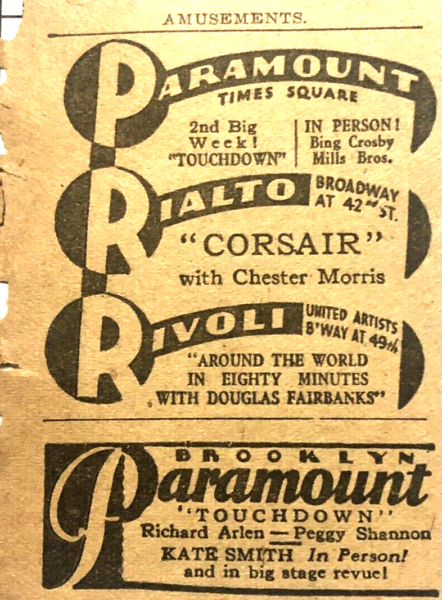
The Subway Crooner on The Road to Brooklyn
Bing had entertained in Brooklyn prior to his Paramount stint. From May 14 to 19, 1928, Paul Whiteman’s Orchestra spotlighted Bing both as vocalist and with The Rhythm Boys, arguably the first pop singing group, played Brooklyn’s Loew’s Metropolitan Theater. From March 1 to 7, 1929 The Rhythm Boys topped the bill in a cine-variety show at Brooklyn’s Fox Theater. The March 4 edition of Brooklyn’s The Standard Union featured a review. “Paul Whiteman’s Rhythm Boys, who made the song ‘Mississippi Mud’ famous, are at the Fox, where an intriguing stage show and the picture True Heaven are swelling the box office receipts.”
By the time Bing embarked upon a solo career in 1931, he had shed the tenor range. He now understood that the microphone favored baritones. Bing assimilated many different styles, ranging from classical to jazz, and fused them into a unique sound, which accounted for his meteoric rise. In March he signed with Brunswick Records. Meanwhile, his scat singing, called “Boo-Boo-Boo-Ing,” was making giant strides. Bing’s first solo broadcast occurred in September, leading to his premiere on November 3 as The Cremo Cigar Singer, henceforward heard daily from New York over CBS. Recent roles in a handful of Mack Sennett shorts attracted attention, but for the majority of the public Bing’s voice was a disembodied one.
Now fans could see him in the flesh at The New York Paramount. When Rudy Vallee, who had previously played there, introduced Bing at his debut on November 6, 1931. This was a ceremonial passing of the torch. Vallee, acknowledging that “his heyday was over once he heard Bing,” dropped his megaphone and conceded.
As Bing was becoming known as “The King of the Crooners,” Russ Columbo emerged as a threat to the throne. Columbo’s agent, songwriter Con Conrad persuaded Columbo that perhaps he could rival Bing’s ascendancy. He arranged for his client to sign recording and radio contracts with Bing’s competitors. A publicity bonanza was fueled, and “The Battle of the Baritones” began. The crooner combat intensified when Bob Weitman, manager of both Paramount theaters, booked Columbo into the Brooklyn Paramount. This clever maneuver deliberately coincided with Bing’s engagement at the New York Paramount. Columbo opened on November 26, 1931 and played there until February 10, 1932. Gary Giddins elaborates in the first volume of his biography, A Pocketful of Dreams (Little Brown & Company; 2001) “The Paramount front office booked Columbo into the Brooklyn theater during part of Bing’s Broadway run but it tilted its booking powers toward Bing, whose shows were more elaborate. Paramount increased his salary to $4000 when it extended his contract (it did not renew Columbo’s), a tribute as much to his personal stability as to his drawing power.”
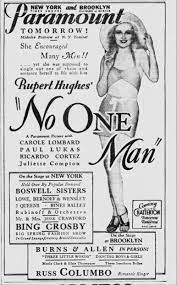
Taking advantage of their overlapping engagements, the two singers occasionally swapped appearances, rushing on the train to substitute for each other to the delight of their respective fans. This situation gained Bing the sobriquet, “The Subway Crooner,” as Bing recalled to The New York Times in December, 1976. “In the old days, I did five shows a day. One week I doubled at the New York Paramount and The Brooklyn Paramount. I went by subway from Times Square—eight shows a day and a nightly radio broadcast.” Indeed, the mock feud inspired a hit tune, “Crosby, Columbo and Vallee.”
There’s lots of public enemies, but I know only three
They’ve made a million married women wish that they were free
Crosbymania
Once his Brooklyn Paramount engagement ended, Columbo replaced Bing at the New York Paramount, just as Bing began his stay at The Brooklyn Paramount on February 12, 1932, having completed the day before his record breaking run at the crossroads of the world. Billed as “the romantic singer of songs you love,” Bing entertained in Brooklyn for six weeks until March 24, 1932. The theater’s press office heralded his appearance with this ballyhoo. “Brooklyn’s first chance to hear him – Bing Crosby, the Rhythm Boy who made good. An indefinite stay. He’s hot! He’s torrid! He’s your favorite torch singer of songs you love. Everybody will like Bing, a regular fellow.”
The hoopla created a groundswell of excitement in a rapidly growing female fan base, my mother among them, who vividly recalled the mayhem caused by throngs hoping for a glimpse of the star. An indication of this fervor is found in the January 1932 issue of Maroon and White, published for students of the all-girl Bay Ridge High School in Brooklyn. An article entitled “Writing an Essay” advises, “Why not write about what we know most about. No, not Bing Crosby this time, but -crushes. Ah, what we could write about our Crush.” The advice went mostly unheeded and the Depression didn’t seem to matter as an archetype was being minted, that of the traffic-disrupting, heart-throbbing musical idol, the blueprint for Sinatra and Presley and The Beatles to follow.
Each week consisted of Bing headlining a cine-variety show five times a day. The cast included an eight-member female dance troupe. One of them was Grace Bradley, an actress featured in a few of Bing’s thirties films and the widow of William Boyd, better known as “Hopalong Cassidy.” Bradley, who was born in Brooklyn’s Borough Park section, remembered her time at The Brooklyn Paramount in an interview she gave me in 2008. (Bradley died in 2010.) “The audience reaction was very good. I don’t remember any tearing of clothes or anything like that. The crowds weren’t riotous like the bobbysoxers later on. Russ was so good looking, with a great voice, but Bing was the one I was crazy about.” Bradley also commented on the grind of playing vaudeville in Brooklyn. “I was doing so many shows that I was losing two pounds a day. It was a matter of life and death! There wasn’t much relaxation. You didn’t even have time to eat. When you start in the morning and work until midnight – it gets to where you don’t have any personal life. You just exist!”
According to Giddins, “Reviewers noted Bing’s equanimity – he did not appear to mind having to sing while obscured by a bevy of dancing girls – as well as his ‘quiet line of clowning’ and his innovative decision to plant his main microphone in the orchestra pit.” In his autobiography Call Me Lucky (Simon and Schuster: 1953) Bing recalled his time at The Paramount. “I was used as a master of ceremonies. I sang a song or two, worked in with some of the specialty acts, or did straight for visiting comics. Being an emcee turned out to be rather a merry assignment. I found I could be quite a gabby fellow. I’d always been fascinated by words and their meaning.” Often Bing was presented singing off stage, in half darkness or in silhouette. There would sometimes be as many as three microphone setups so that he could roam the sprawling stage and serenade from different positions.
Among the classics he waxed during this time and most likely sang in Brooklyn were “Starlight,” “How Long It Will Last,” “My Woman,” “Love, You Funny Thing,” “Shine” with The Mills Brother, “Soft Lights and Sweet Music,” and “Paradise.” On February 12, 2012, at Brooklyn’s Greenhouse Café in Brooklyn, pianist Pete Sokolow accompanied me for a program of these chestnuts to commemorate the 80th anniversary of Bing’s Brooklyn Paramount debut.
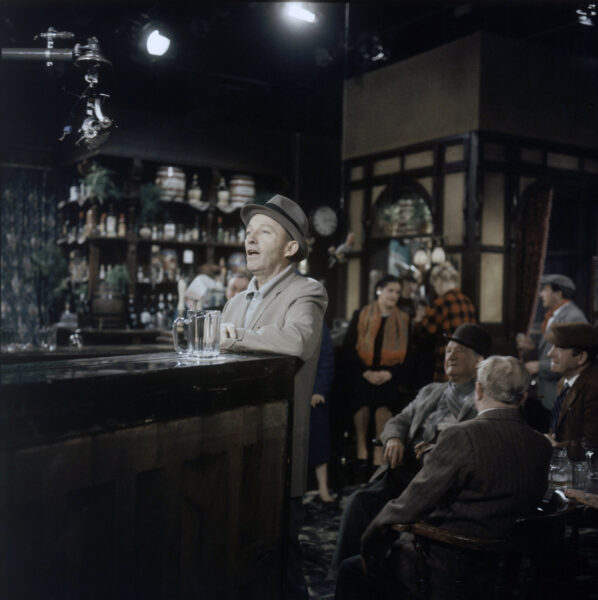
Fred Allen succeeded Bing at The Brooklyn Paramount the next week (March 25 -March 31, 1932). Bing returned to the New York Paramount on March 25, 1932, just one day after his Brooklyn contract expired, and continued there until April 7, at the salary of $4000.00 per week. He would never return to perform at The Brooklyn Paramount.
Live shows at The Brooklyn Paramount ceased by the mid-thirties, but the fifties saw a renaissance with legendary concerts featuring, among others, Stan Kenton’s Festival of Modern American Jazz, Norman Granz’ Jazz at the Philharmonic, The Birdland All Stars, and The Allan Freed Rock and Roll Shows. This gilded Mecca of pop culture closed its doors as a movie theater in 1962 and as a music arena in 1971. It is now home to the Brooklyn Campus of Long Island University. Converted for use as classroom space and a gymnasium, the building retains much of the theater’s original decorative detail.
On June 6, 2006, with arrangements made with my assistance, Bing’s wife, Kathryn Crosby, made an extensive tour of the lobby and corridors, culminating at the awesome stage. She even sat at the mighty Wurlitzer organ and enjoyed seeing the display of original posters of the many Paramount films screened at the theater. A symposium, Vaudeville at The Brooklyn Paramount, took place on site on April 25, 2008 to “explore the wide-ranging cultural impact of the theater.” Among those examining Bing’s contribution were myself and Joe Franklin, TV host of “Memory Lane.” There are plans for a restoration supervised by Live Nation to restore the theater while retaining many of the existing features. The 3,000-capacity theater is slated to open to the public in 2024.
A total of 36 of Bing’s Paramount films received their borough premiere at The Brooklyn Paramount. Starting in 1949, the promotional campaigns for all of Bing’s Paramount films were overseen by Jerome Pickman, a former Brooklyn Eagle reporter who, until 1962, was the studio’s vice president in charge of worldwide advertising and publicity. In my capacity as curator for the Crosby retrospective which The Film Society of Lincoln Center conducted in 2005, an invitation was offered to Pickman to participate. He chose to introduce The Country Girl, relating how he was responsible for the production and how he persuaded his close friend to play the uncustomary role of a has-been drunken star seeking a comeback. The movie garnered Bing his third Oscar nomination for Best Actor (He won for Going My Way) and Grace Kelly her Oscar for Best Actress of 1954.
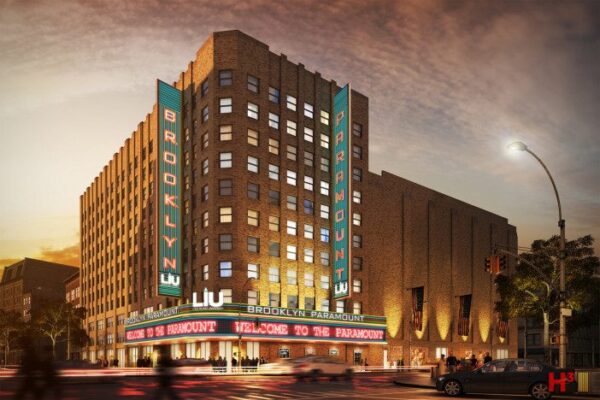
Bing Around the Borough
Upon completion of Bing’s commitments to both Paramount theaters, his brother Everett, an habitue of Peter Lugar’s steakhouse in Williamsburg, negotiated a personal appearance tour. Bing agreed, provided his accompanist Eddie Lang, called “The Father of Jazz Guitar,” to join him, as he had during the weeks in Brooklyn. From January 14 to 20, 1933 Bing appeared at the Albee Theater in Brooklyn, in a cine-variety bill with Weber and Fields, earning $3,000 for the week. This review was in the Brooklyn Times Union of January 14. “Bing Crosby brings his crooning voice to the stage of the Albee in a triumphant return to Brooklyn. Crosby is the show’s headliner, entertaining with a well selected group of songs. But Bing is well supported in the stage presentation by those two old comic favorites of a former generation, Weber and Fields”. On January 17, 1933, Bing made a personal appearance at Loeser’s Music Shop in Brooklyn to sign autographs. On March 26, Bing was devastated when Lang died at the age of thirty-one from tonsillectomy complications. Bing would eventually find a replacement in Les Paul.
Bing regularly returned to Brooklyn, especially to indulge his passion for baseball. On October 9, 1932 he went to Ebbets Field to see the Staten Island Stapletons surprisingly beat the Brooklyn Dodgers 7-6. On June 4, 1947 he witnessed the Dodgers beat the Pirates nine to four. Bing had a personal stake, being a Pirates co-owner. On June 5 he watched the Dodgers again beat the Pirates 3-nothing. Bing left before the end of the game. On May 21 and 22, 1948 he left a happier man when the Pirates beat the Dodgers 8-4 then 3-1.
In Call Me Lucky Bing wrote about a humorous Brooklyn baseball memory. “One summer in New York Groucho Marx and I headed for Ebbets Field to watch the Pirates play Brooklyn. I’d better point out to hinterlanders that New York hack drivers hate driving fares to the Brooklyn ball park because it’s a long way and they run the risk of cruising back to Manhattan empty – ‘deadheading,’ as they call it in railroading. However, we merrily hailed a taxi on Fifth Avenue, and boarded it bearing with us a package of sandwiches and other delicacies, including a bottle of cognac which had been presented to us by a friend, Leo Lindy, the genial Broadway restauranter. When we reached Brooklyn, the driver got lost and had to make several stops to inquire the route to Ebbets Field. Of course, each time he came back to the cab he was a clay pigeon for Groucho’s taunts…Even while Groucho was paying the driver, the quips were still flying back and forth.”
“Once we were inside the park and comfortably seated, like all baseball fans we decided to eat. Chatting happily about the repast we were about to enjoy, we found that we’d left our lunch in the taxi… We feasted philosophically on hot dogs and cokes, and speculated calmly concerning the possible whereabouts and doings of our friend the cabbie. Undoubtedly in the cool evening his blood pressure would return to normal and he would have a picnic lunch with his fair lady in Prospect Park…The whole thing might be summed up as The Case Of The Taxi Driver’s Revenge.”
On August 14, 1944, before Bing and his USO unit gave an Impromptu show at The Brooklyn Port or Embarkation in Sunset Park
prior to leaving for England and France. Hope and Crosby’s morale boosting Road to films are peppered with borough references. Dorothy Lamour and Una Merkel, their female cohorts in Road to Zanzibar, are a pair of Brooklyn entertainers, pursuing a millionaire hunter. In 1946 there were unrealized plans for Road to Brooklyn. When Bing recorded Road to Morocco, the song contained Johnny Burke’s lyrics not heard in the film.
Let’s meet on the Road to Morocco – Instead of the tunnel of love
The desert nights, the Arab tents, harem atmosphere
‘Bout the best attraction Coney Island has this year
Let’s meet on the road to Morocco
Though our Brooklyn moon shines above
I’ll whisper how I love you to the strains of native flutes
And your arms will thrill me more than all the shoot-toot-toots
Tell the gang so they won’t hang around
Like Webster’s Dictionary, we’re Morocco bound
At war’s end Bing was the number one draw in movies, records and broadcasts. There was no surprise when, in 1948, Bing was voted “The most admired man alive.” Above all, generations found a close friend in his warm persona. When his star was on the rise Brooklyn provided Bing a splendid showcase and in so doing paved the way for America’s Troubadour, born 120 years ago this May.
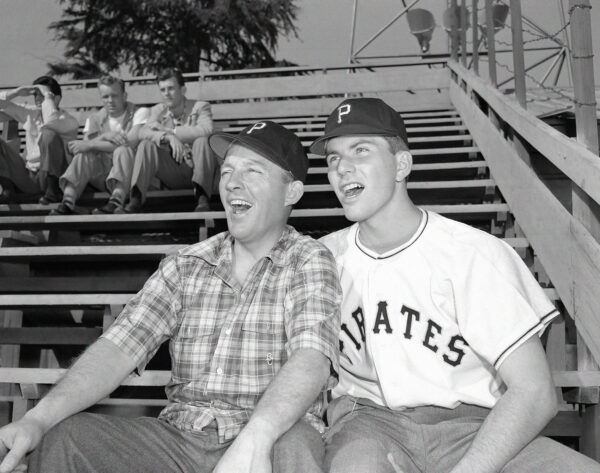
Details of Bing Crosby’s Brooklyn Paramount Engagement
What follows is a documentation of Bing’s six weeks in Brooklyn, including the films which were part of the presentations, compiled from advertisements, promos, bills of fare and reviews found in contemporary newspapers such as The Brooklyn Eagle. Another source is The International Club Crosby’s diary, Day by Day, found at the website for Bing Magazine.
Wayward w/Nancy Carroll, Richard Arlen
& On Stage: Brooklyn’s first chance to hear him – Bing Crosby, the Rhythm Boy who made good! w/Lilyann Tashman (Brooklyn’s own wise cracking screen star), Milton Douglas, Sid Silvers, The 6 Steppers, Merle and Elsie, and sixteen Danny Dare Dancers. (Dare would go on to choreograph Holiday Inn, Star Spangled Rhythm, and Road to Utopia and to produce Road to Rio.)
“The rounds of applause which greeted his every performance last week have caused Bing Crosby, radio and stage star, to be held over at the local Paramount Theater for a second week beginning today. Those lucky 30 persons who won Home Talk theater courtesies for the Paramount, and who saw him with Lilyan Tashman last week, were won over by his delightful mannerisms.”
(The Brooklyn Daily Eagle, February 19, 1932)
Nice Women w/Sidney Fox, Frances Dee.
& On Stage: Held Over! Bing Crosby, to satisfy the demands of thousands, singing the love songs that are thrilling a nation! w/Vox and Walters, John and Edna Torrence, the Bredwins, Miriam Lax, The David Bines Ballet, Merle and Elsie, the Paramount Orchestra in Holiday Overture. Doors open today at ten-thirty a.m. $.25 till 2 p.m.
“…Under the leadership of Bing Crosby, Brooklyn audiences will again find much to prove their wisdom in deciding that he be retained for a second week. Crosby’s particular adeptness in singing sweet tunes as well as rhythmic melodies, coupled with his ability as a light comedian, stopped almost every show in his performances at the Paramount last week.”
(The Brooklyn Daily Times, February 21, 1932)
Broken Lullaby (formerly The Man I Killed) w/Lionel Barrymore, Nancy Carroll. (An Ernst Lubitsch production) & On Stage:
Bing Crosby! Third Big Week By Popular Demand. Nothing Like It Before. Now In His Own Show! Written By Bing Himself! w/The Collette Sisters, Fields, Smith, and Fields, Kendall Capps. Merle and Elsie will do a puppet show operating them on the manuals of the organ! And Special Attraction: Burns and Kissen.
“…In the current stage presentation, “Bing! Bang!” at the Brooklyn Paramount, Bing’s riotous acting, his humorous “lines” and situations which provoke hilarity, are all the product of his creative mind. Although he has written a script for the entire stage production, Crosby seldom finishes one show in the same manner as its predecessor, his penchant for “ad-libbing” prompting many admirers to sit through two or three shows at a time.”
(The Brooklyn Daily Times, February 28, 1932)
Strangers in Love w/Frederic March, Kay Francis & On Stage:
New Kind of Fun – Even a New Kind of Love – Bing Crosby in “Time Goes By,” His own idea of musical comedy newer than next year’s “Follies.” w/Yorke and King (comedy), Rubinoff & his Magic Violin (triumphant return) w/the Paramount Concert Orchestra. Plus: Madeline Killeen, Reilly Kids, Warren Boden, and Merle and Elsie (a merry song spree at the twin organs.
The Wiser Sex w/Claudette Colbert & On Stage:
Have a fling with Bing in Big Whoopee Show. w/Johnny Burke, The Three Swifts, Ayers and Rene Company, Dancing Beauty, Merle and Elsie, The Paramount Concert Orchestra. Doors open at 10:30 a.m.; $.25 before 2 p.m. every day but Saturday and Sunday for the big show and screen show.
On March 15 Bing led the Brooklyn Paramount bowling team as they defeat the Brooklyn Times-Standard Union team in a match at Dwyer’s Bowling Academy.
Dancers in the Dark w/Miriam Hopkins, Jack Oakie
& On Stage: Bing Crosby! Extra Farewell week! Come Thrill to “Bing” as he cuts loose with is hottest rhythms in the final and best show of his sensational engagement!
w/Pola Negri (in an original dramatic sketch by Jack Lait).
Plus “Revue International” (cast of fifty), Yacopi Troupe, Lee Gail Ensemble, David Bines Ballet, Merle and Elsie.
“…Firstly, you’ll see the glamorous film star Pola Negri in a skit. Also, on the stage will be seen the youthful radio idol Bing Crosby, who is to be seen in his sixth and last week on the Paramount stage. His own gags, his own humor, and his own productions have aided in making this lad one of the most enjoyable personalities yet to be presented on the stage of the Brooklyn Paramount.” (The Brooklyn Daily Eagle, March 18, 1932)
Bing Crosby Films Screened at The Brooklyn Paramount
1) October 14th, 1932 The Big Broadcast
2) September 22, 1933 Too Much Harmony
3) May 11th, 1934 We’re Not Dressing
4) September 21st, 1934 She Loves Me Not
5) December 26th, 1934 Here is My Heart
6) May 3rd, 1935 Mississippi
7) September 13th, 1935 Two for Tonight
8) August 21st, 1936 Rhythm on the Range
9) April 9th, 1937 Waikiki Wedding
10) September 22nd, 1937 Double or Nothing
11) May 25th, 1938 Doctor Rhythm
12) September 20th, 1939 The Star Maker
13) April 3rd, 1940 Road to Singapore
14) September 18th, 1940 Rhythm on the River
15) December 24th, 1941 Birth of the Blues (held over 1 week)
16) September 2nd, 1942 Holiday Inn (held over 3 weeks)
17) February 11th, 1943 Star Spangled Rhythm (held over 7
weeks)
18) May 29th, 1944 Going My Way (held over 9 weeks)
19) February 21st, 1945 Here Come the Waves
20) May 2nd, 1946 Road to Utopia (held over 2 weeks)
21) December 26th, 1946 Blue Skies (held over 3 weeks)
22) October 2nd, 1947 Welcome Stranger (held over 3 weeks)
23) November 20th, 1947 Variety Girl (held over 2 weeks)
24) April 22nd, 1948 Road to Rio (held over 2 weeks)
25) September 2nd, 1948 The Emperor Waltz
26) May 18th, 1949 Connecticut Yankee (held over 2 week)
27) September 28th, 1949 Top O’ The Morning (held over 1 week)
28) November 16th, 1949 Holiday Inn (reissue)
29) May 5th, 1950 Riding High (held over 1 week)
30) January 2nd, 1951 Mr. Music (held over 2 weeks)
31) November 6th, 1951 Here Comes the Groom (held over 1
week)
32) November 12th, 1952 Just for You (held over 1 week)
33) March 11th, 1953 Road to Bali (held over 1 week)
34) December 30th, 1953 Little Boy Lost (held over 1 week)
35) December 11th, 1954 White Christmas (held over 2 weeks)
36) March 9th, 1955 The Country Girl (held over 2 weeks)
37) April 21st, 1956 Anything Goes (held over 1 week)
38) February 16th, 1961 High Society (reissue)




